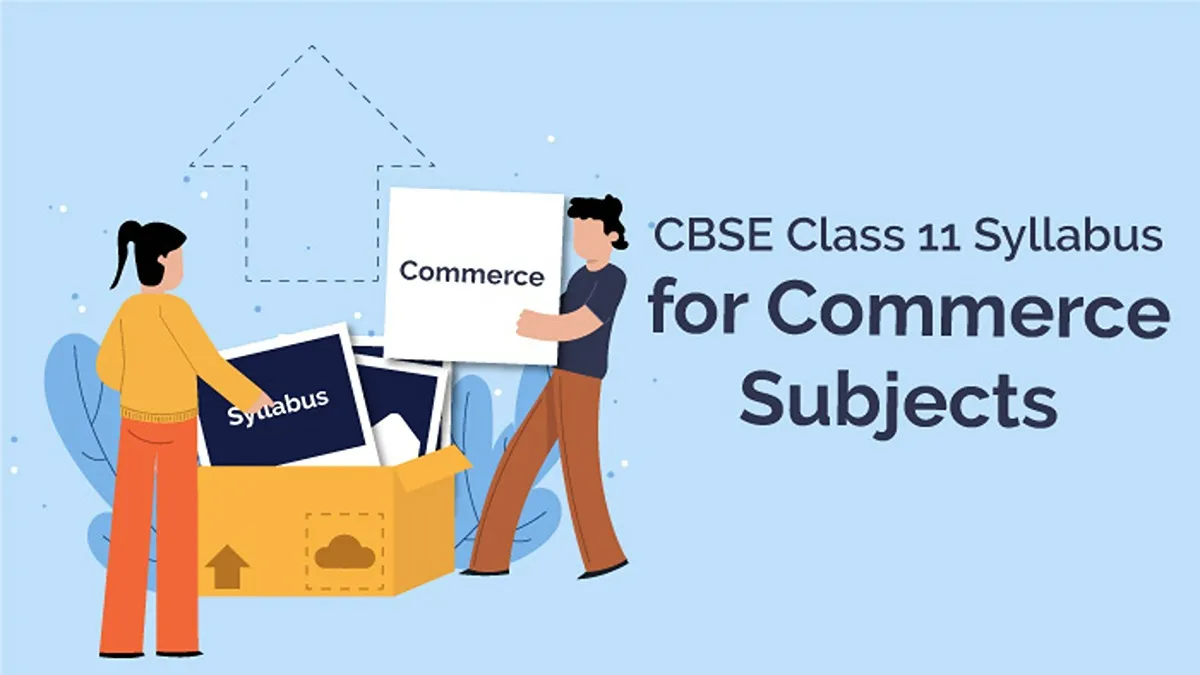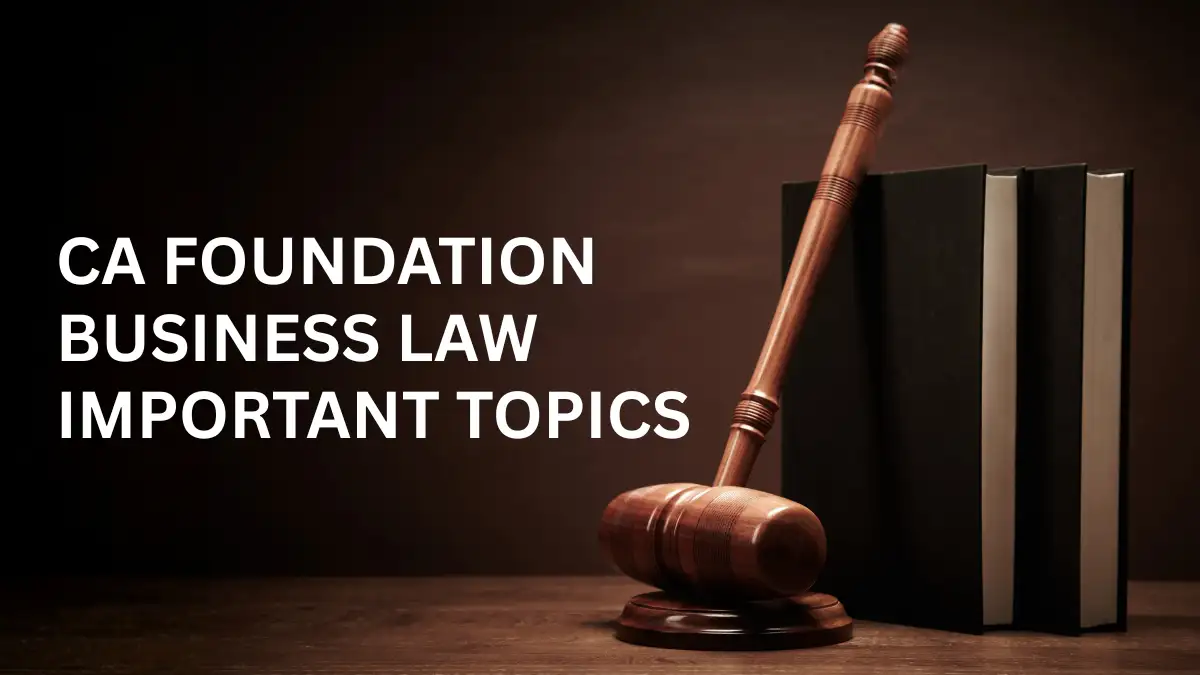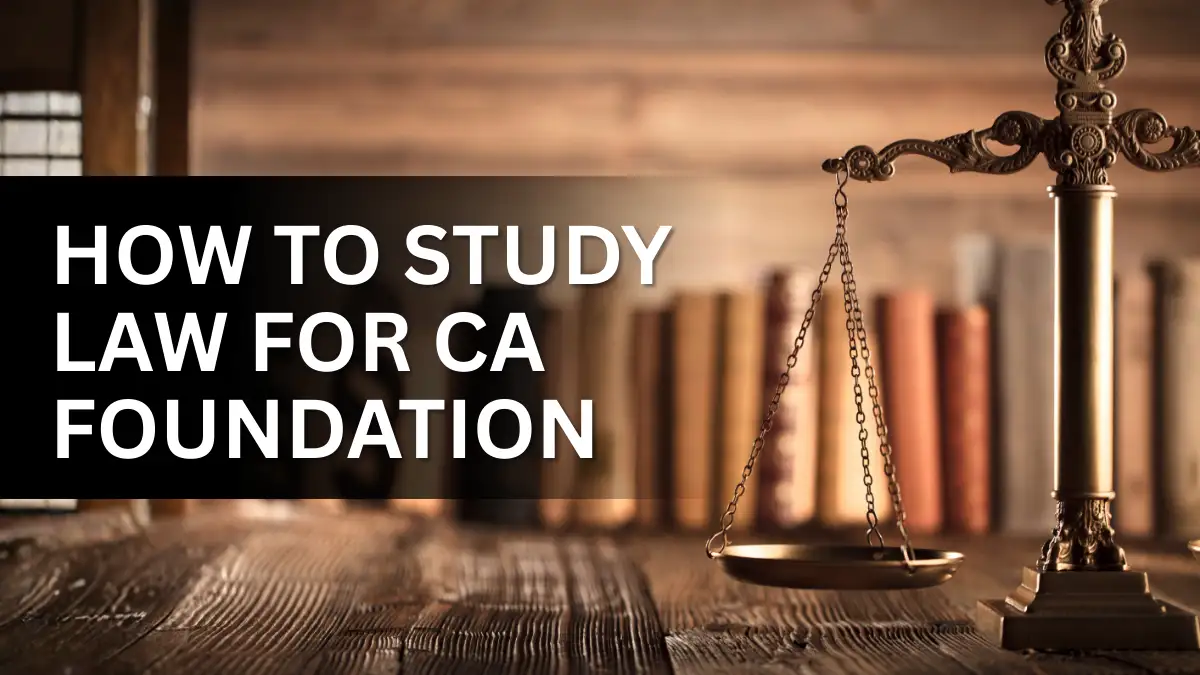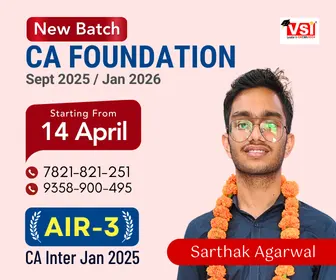Welcome to CA Wizard, the free online portal for all your academic requirements! You can find the latest syllabus, marking scheme, sample papers, previous year question papers, the best study tips, and much more on our website. We help class 11, class 12, CA course students stay-up-to-date for their exam preparation.
In this article, we are sharing the complete CBSE Class 11 Syllabus for Commerce stream students. The main subjects of the Commerce, i.e., Accountancy, Business Studies, Economics, Entrepreneurship, and Mathematics, are covered in this article.
As you know, CBSE has reduced the Class 11 Syllabus for Commerce and other stream subjects; therefore, you must know the topics deleted from the syllabus. You should mark the topics in your books, notes, and other study material. If you want, you can download the CBSE class 11 syllabus for Commerce Subjects.
We also recommend you to join the 11th commerce classes for completion of class with good marks. Now below is the syllabus given to you.
Download CBSE Class 11 Syllabus for Commerce PDF
| Subjects | |
| Accounts | Download |
| Business Studies | Download |
| Economics | Download |
| Entrepreneurship | Download |
| Math | Download |
CBSE Class 11 Syllabus for Commerce – Accountancy (2023-24)
Part A Financial Accounting -1
Unit 1 Theoretical Framework
| Topics covered in Syllabus |
| Introduction to AccountingAccounting- concept, objectives, advantages and limitations, types of accounting information; users of accounting information and their needs. Qualitative Characteristics of Accounting Information. Role of Accounting in Business. Basic Accounting Terms- Business Transaction, Capital, Drawings. Liabilities (Non Current and Current). Assets (Non Current, Current); Fixed assets (Tangible and Intangible), Expenditure (Capital and Revenue), Expense, Income, Profit, Gain, Loss, Purchase, Sales, Goods, Stock, Debtor, Creditor, Voucher, Discount (Trade discount and Cash Discount) Theory Base of Accounting • Fundamental accounting assumptions: GAAP: Concept • Business Entity, Money Measurement, Going Concern, Accounting Period, Cost Concept, Dual Aspect, Revenue Recognition, Matching, Full Disclosure, Consistency, Conservatism, Materiality and Objectivity • System of Accounting. Basis of Accounting: cash basis and accrual basis • Accounting Standards: Applicability in IndAS • Need of IFRS • Goods and Services Tax (GST): Characteristics and Objective. |
Unit 2 Accounting Process
| Topics covered in Syllabus |
| Recording of Business Transactions• Voucher and Transactions: Source documents and Vouchers, Preparation of Vouchers, Accounting Equation Approach: Meaning and Analysis, Rules of Debit and Credit. (Traditional and Modern Approach) • Recording of Transactions: Books of Original Entry-Journal • Special Purpose books: • Cash Book: Simple, cash book with bank column and petty cashbook • Purchases book • Sales book • Purchases return book • Sales return book • Ledger: Format, Posting from journal and subsidiary books, Balancing of accounts Bank Reconciliation Statement: Bank Reconciliation Statement with Adjusted Cash Book Accounting for Bills of Exchange Retirement of bill Renewal of bill • Need and preparation Depreciation, Provisions and Reserves • Depreciation: Concept, Features, Causes, factors • Other similar terms: Depletion and Amortisation • Methods of Depreciation: i. Straight Line Method (SLM) ii. Written Down Value Method (WDV) Note: Excluding change of method • Difference between SLM and WDV; Advantages of SLM and WDV • Accounting treatment of depreciation i. Charging to asset account ii. Creating provision for depreciation/accumulated depreciation account iii. Treatment for disposal of asset • Provisions and Reserves: Difference • Types of Reserves: i. Revenue reserve ii. Capital reserve iii. General reserve iv. Specific reserve v. Secret Reserve • Difference between capital and revenue reserve Accounting for Bills of Exchange • Bill of exchange and Promissory Note: Definition, Specimen, Features, Parties. • Difference between Bill of Exchange and Promissory Note • Terms in Bill of Exchange: i. Term of Bill ii. Accommodation bill (concept) iii. Days of Grace iv. Date of maturity v. Discounting of bill vi. Endorsement of bill vii. Bill after due date viii. Negotiation ix. Bill sent for collection x. Dishonour of bill • Accounting Treatment Trial balance and Rectification of Errors |
Part B Financial Accounting -2
Unit 3 Financial Statements of Sole Proprietorship
| Topics covered in Syllabus |
| Meaning, objectives and importance; Revenue and Capital Receipts; Revenue and Capital Expenditure; Deferred Revenue expenditure. Opening journal entry. Trading and Profit and Loss Account: Gross Profit, Operating profit and Net profit. Preparation. Balance Sheet: need, grouping and marshalling of assets and liabilities. Preparation. Adjustments in preparation of financial statements with respect to closing stock, outstanding expenses, prepaid expenses, accrued income, income received in advance, depreciation, bad debts, provision for doubtful debts, provision for discount on debtors, Abnormal loss, Goods taken for personal use/staff welfare, interest on capital and managers commission. Preparation of Trading and Profit and Loss account and Balance Sheet of a sole proprietorship with adjustments. |
Part C: Project Work (Any One)
- Collection of source documents, preparation of vouchers, recording of transactions with the help of vouchers.
- Preparation of Bank Reconciliation Statement with the given cash book and the passbook with twenty to twenty-five transactions.
- A comprehensive project of any sole proprietorship business. This may state with journal entries and their lingering, preparation of Trial balance. Trading and Profit and Loss Account and Balance Sheet. Expenses, incomes and profit (loss), assets, and liabilities are to be depicted using a pie chart/bar diagram.
CBSE Class 11 Syllabus for Commerce – Business Studies (2023-24)
Part A Foundation of Business
Unit 1 Evolution and Fundamentals of Business
| Topics covered in Syllabus |
| History of Trade and Commerce in India: Indigenous Banking System, Rise of Intermediaries, Transport, Trading Communities: Merchant Corporations, Major Trade Centres, Major Imports and Exports, Position of Indian Sub-Continent in the World Economy.Business – meaning and characteristics Business, profession, and employment concept Objectives of business Classification of business activities – Industry and Commerce Industry-types: primary, secondary, tertiary Meaning and subgroups Commerce-trade: (types-internal, external; wholesale and retail) and auxiliaries to trade; (banking, insurance, transportation, warehousing, communication, and advertising) – meaning Business risk-Concept |
Unit 2 Forms of Business Organizations
| Topics covered in Syllabus |
| Sole Proprietorship-Concept, merits and limitations\Partnership-Concept, types, merits and limitation of partnership, registration of a partnership firm, partnership deed. Types of partners Hindu Undivided Family Business: Concept Cooperative Societies-Concept, merits, and limitations Company – Concept, merits and limitations; Types: Private, Public and One Person Company – Concept Formation of the company – stages, important documents to be used in formation of a company Choice of form of business organization |
Unit 3 Public, Private and Global Enterprises
| Topics covered in Syllabus |
| Public sector and private sector enterprises – ConceptGlobal Enterprises – Feature. Joint ventures, Public private partnership – concept Forms of public sector enterprises: Departmental Undertakings, Statutory Corporations and Government Company |
Unit 4 Business Services
| Topics covered in Syllabus |
| Business services – meaning and types. Banking: Types of bank accounts – savings, current, recurring, fixed deposit and multiple option deposit accountBanking services with particular reference to Bank Draft, Bank Overdraft, Cash credit. E-Banking meaning, Types of digital payment Insurance – Principles. Types – life, health, fire and marine insurance – concept Postal Service – Mail, Registered Post, Parcel, Speed Post, Courier – meaning |
Unit 5 Emerging Modes of Business
| Topics covered in Syllabus |
| E – business: concept, scope and benefits |
Unit 6 Social Responsibility of Business and Business Ethics
| Topics covered in Syllabus |
| Concept of social responsibilityCase of social responsibility Responsibility towards owners, investors, consumers, employees, government and community Role of business in environment protection Business Ethics – Concept and Elements |
Part B Finance and Trade
Unit 7 Sources of Business Finance
| Topics covered in Syllabus |
| Owners’ funds- equity shares, preferences share, retained earnings, Global Depository receipt (GDR), American Depository Receipt (ADR) and International Depository Receipt (IDR) – conceptBorrowed funds: debentures and bonds, loan from financial institution and commercial banks, public deposits, trade credit Borrowed funds: Inter Corporate Deposits (ICD) – Concept |
Unit 8 Small Business and Entrepreneurship Development
| Topics covered in Syllabus |
| Entrepreneurship Development (ED): Concept and Need. Process of Entrepreneurship Development: Start-up India Scheme, ways to fund start-up. Intellectual Property Rights and EntrepreneurshipSmall scale enterprise – Definition Role of small business in India with special reference to rural areas Government schemes and agencies for small scale industries: National Small Industries Corporation (NSIC) and District Industrial Centre (DIC) with special reference to rural, backward areas |
Unit 9 Internal Trade
| Topics covered in Syllabus |
| Types of retail-trade-Itinerant and small scale fixed shops retailersInternal trade – meaning and types of services rendered by a wholesaler and a retailer Large scale retailers-Departmental stores, chain stores – concept GST (Goods and Services Tax): Concept |
Unit 10 International Business
| Topics covered in Syllabus |
| International trade: concept and benefitsExport trade – Meaning and procedure Import Trade – Meaning and procedure Documents involved in International Trade: indent, letter of credit, shipping order, shipping bills, mate’s receipt (DA/DP) World Trade Organization (WTO) meaning and objectives |
Project Work
As per CBSE guidelines.
CBSE Class 11 Syllabus for Commerce – Economics (2023-24)
Part A: Statistics for Economics
Unit 1: Introduction
| Topics covered in Syllabus |
| What is Economics?Meaning, scope, functions and importance of statistics in Economics |
Unit 2: Collection, Organisation and Presentation of data
| Topics covered in Syllabus |
| Collection of data – sources of data – primary and secondary; how basic data is collected with concepts of Sampling; methods of collecting data; some important sources of secondary data: Census of India and National Sample Survey Organisation.Organisation of Data: Meaning and types of variables; Frequency Distribution. Presentation of Data: Tabular Presentation and Diagrammatic Presentation of Data: (i) Geometric forms (bar diagrams and pie diagrams), (ii) Frequency diagrams (histogram, polygon and Ogive) and (iii) Arithmetic line graphs (time series graph). |
Unit 3: Statistical Tools and Interpretation
| Topics covered in Syllabus |
| For all the numerical problems and solutions, the appropriate economic interpretation may be attempted. This means, the students need to solve the problems and provide interpretation for the results derived.Measures of Central Tendency- Arithmetic mean, median and mode Correlation – meaning and properties, scatter diagram; Measures of correlation – Karl Pearson’s method (two variables ungrouped data) Spearman’s rank correlation. Introduction to Index Numbers – meaning, types – wholesale price index, consumer price index and index of industrial production, uses of index numbers; Inflation and index numbers. |
Part B: Introductory Microeconomics
Unit 4: Introduction
| Topics covered in Syllabus |
| Meaning of microeconomics and macroeconomics; positive and normative economicsWhat is an economy? Central problems of an economy: what, how and for whom to produce; opportunity cost. |
Unit 5: Consumer’s Equilibrium and Demand
| Topics covered in Syllabus |
| Consumer’s equilibrium – meaning of utility, marginal utility, law of diminishing marginal utility, conditions of consumer’s equilibrium using marginal utility analysis.Indifference curve analysis of consumer’s equilibrium-the consumer’s budget (budget set and budget line), preferences of the consumer (indifference curve, indifference map) and conditions of consumer’s equilibrium. Demand, market demand, determinants of demand, demand schedule, demand curve and its slope, movement along and shifts in the demand curve; price elasticity of demand – factors affecting price elasticity of demand; measurement of price elasticity of demand – percentage-change method. |
Unit 6: Producer Behaviour and Supply
| Topics covered in Syllabus |
| Meaning of Production Function – Short-Run and Long-RunTotal Product, Average Product and Marginal Product. Returns to a Factor Cost: Short run costs – total cost, total fixed cost, total variable cost; Average cost; Average fixed cost, average variable cost and marginal cost-meaning and their relationships. Producer’s equilibrium-meaning and its conditions in terms of marginal revenue-marginal cost. Revenue – total, average and marginal revenue – meaning and their relationship. Supply, market supply, determinants of supply, supply schedule, supply curve and its slope, movements along and shifts in supply curve, price elasticity of supply; measurement of price elasticity of supply – percentage-change method. |
Unit 7: Forms of Market and Price Determination under Perfect Competition with simple applications
| Topics covered in Syllabus |
| Perfect competition – Features; Determination of market equilibrium and effects of shifts in demand and supply.Simple Applications of Demand and Supply: Price ceiling, price floor. |
Project Work
As per CBSE guidelines.
CBSE Class 11 Syllabus for Commerce – Entrepreneurship (2023-24)
Theory
Chapter 1: Entrepreneurship: Concepts and functions
| Topics covered in Syllabus |
| Entrepreneurship – Concept, Functions and Need• Why Entrepreneurship for You • Myths about Entrepreneurship • Advantage and Limitations of Entrepreneurship • Process of Entrepreneurship • Entrepreneurship – The Indian Scenario |
Chapter 2: An Entrepreneur
| Topics covered in Syllabus |
| • Why be an Entrepreneur• Types of Entrepreneurs • Competencies and characteristics • Entrepreneurial Values, Attitudes and Motivation • Intrapreneur: Meaning and Importance |
Chapter 3: Entrepreneurial journey
| Topics covered in Syllabus |
| • Idea generation.• Feasibility Study and opportunity assessment • Business Plan: meaning, purpose and elements • Execution of Business Plan |
Chapter 4: Entrepreneurship as innovation and problem solving
| Topics covered in Syllabus |
| • Entrepreneurs as problem solvers• Innovations and Entrepreneurial Ventures – Global and Indian • Role of Technology – E-commerce and Social Media • Social Entrepreneurship – Concept |
Chapter 5: Concept of market
| Topics covered in Syllabus |
| • Market; Concept, Types• Micro and Macro Market Environment • Market Research – Concept, Importance and Process • Marketing Mix |
Chapter 6: Business Finance and arithmetic
| Topics covered in Syllabus |
| • Unit of Sale, Unit Price and Unit Cost – for single product or service• Types of Costs – Start up, Variable and Fixed • Break Even Analysis – for single product or service |
Chapter 7: Resource mobilization
| Topics covered in Syllabus |
| • Types of Resources –Physical, Human, Financial and Intangible.• Selection and utilization of human resources and professionals like Accountants, Lawyers, Auditors, Board Members, etc. |
CBSE Class 11 Syllabus for Commerce – Maths (2023-24)
Unit I Sets and Functions
Chapter 1: Sets
| Topics covered in Syllabus |
| Sets and their representations. Empty set. Finite and Infinite sets. Equal sets. Subsets. Subsets of a set of real numbers especially intervals (with notations). Power set. Universal set. Venn diagrams. Union and Intersection of sets. Difference of sets. Complement of a set. Properties of Complement |
Chapter 2: Relations and Functions
| Topics covered in Syllabus |
| Ordered pairs. Cartesian product of sets. Number of elements in the Cartesian product of two finite sets. Cartesian product of the set of reals with itself (up to RXRXR )..Definition of relation, pictorial diagrams, domain, co-domain and range of a relation. Function as a special type of relation. Pictorial representation of a function, domain, co-domain and range of a function. Real valued functions, domain and range of these functions, constant, identity, polynomial, rational, modulus, signum, exponential, logarithmic and greatest integer functions, with their graphs. Sum, Difference, product and quotients of functions. |
Chapter 3: Trigonometric Functions
| Topics covered in Syllabus |
| Positive and negative angles. Measuring angles in radians and in degrees and conversion from one measure to another. Definition of trigonometric functions with the help of unit circle. Truth of the identity sin2x + cos2x = 1, for all x. Signs of trigonometric functions. Domain and range of trigonometric functions and their graphs. Expressing sin (x±y) and cos (x±y) in terms of sinx, siny, cosx & cosy and their simple applications. Deducing identities like the following:tan(x ± y) = tan x ± tan y / 1 ∓ tan x tan y , cot(x ± y) = cot x cot y ∓ 1 / cot y ± cot x sinα ± sinβ = 2sin 1/2 (α ± β)cos 1/2 (α ∓ β) cosα + cosβ = 2cos 1/2 (α + β)cos 1/2 (α − β) 𝑐𝑜𝑠𝛼 − 𝑐𝑜𝑠𝛽 = −2𝑠𝑖𝑛 1/2 (𝛼 + 𝛽)𝑠𝑖𝑛 1/2 (𝛼 − 𝛽) Identities related to sin2x, cos2x, tan2 x, sin3x, cos3x and tan3x. |
Unit II Algebra
Chapter 5: Complex Numbers and Quadratic Equations
| Topics covered in Syllabus |
| Need for complex numbers, especially√−1, to be motivated by inability to solve some of the quardratic equations. Algebraic properties of complex numbers. Argand plane. |
Chapter 6: Linear Inequalities
| Topics covered in Syllabus |
| Linear inequalities. Algebraic solutions of linear inequalities in one variable and their representation on the number line. |
Chapter 7: Permutations and Combinations
| Topics covered in Syllabus |
| Fundamental principle of counting. Factorial n. (n!) Permutations and combinations, formula for nPr and nCr, simple applications. |
Chapter 8: Binomial theorem
| Topics Covered in Syllabus |
| Historical perspective, statement and proof of the binomial theorem for positive integral indices. Pascal’s triangle, General and middle term in binomial expansion, simple applications. |
Chapter 9: Sequence and Series
| Topics covered in Syllabus |
| Sequence and Series. Arithmetic Progression (A. P.). Arithmetic Mean (A.M.) Geometric Progression (G.P.), general term of a G.P., sum of n terms of a G.P., infinite G.P. and its sum, geometric mean (G.M.), relation between A.M. and G.M. |
Unit III Coordinate Geometry
Chapter 10: Straight Lines
| Topics covered in Syllabus |
| Brief recall of two dimensional geometry from earlier classes. Slope of a line and angle between two lines. Various forms of equations of a line: parallel to axis, point -slope form, slope-intercept form, two-point form, intercept form and normal form. General equation of a line. Distance of a point from a line. |
Chapter 11: Conic Sections
| Topics covered in Syllabus |
| Sections of a cone: circles, ellipse, parabola, hyperbola. Standard equations and simple properties of parabola, ellipse and hyperbola. Standard equation of a circle. |
Chapter 12: Introductory to Three-dimensional Geometry
| Topics covered in Syllabus |
| Coordinate axes and coordinate planes in three dimensions. Coordinates of a point. Distance between two points. |
Unit IV Calculus
Chapter 13: Limits and Derivatives
| Topics covered in Syllabus |
| Derivative introduced as rate of change both as that of distance function and geometrically. Intuitive idea of limit. Limits of polynomials and rational functions trigonometric, exponential and logarithmic functions .Definition of derivative relate it to scope of tangent of the curve, derivative of sum, difference, product and quotient of functions. Derivatives of polynomial and trigonometric functions. |
Unit V Statistics and Probability
Chapter 15: Statistics
| Topics covered in Syllabus |
| Measures of Dispersion: Range, Mean deviation, variance and standard deviation of ungrouped/grouped data. |
Chapter 16: Probability
| Topics covered in Syllabus |
| Random experiments; outcomes, sample spaces (set representation). Events; occurrence of events, ‘not’, ‘and’ and ‘or’ events, exhaustive events, mutually exclusive events, Probability of an event, probability of ‘not’, ‘and’ and ‘or’ events. |
Most Frequently Asked Questions
Q1. What is the CBSE Class 11 Syllabus for Commerce?
Ans. The entire syllabus for commerce subjects is given here in this article on CA Wizard.
Q2. Which books should you study from, for Commerce subjects?
Ans. NCERT books are recommended for commerce subjects class 11. From CA Wizard, you can download the NCERT e-books of all Commerce subjects.
Q3. Is the CBSE class 11 syllabus for Commerce subjects changed?
Ans. Yes, CBSE has done some minor changes in the syllabus for the final exam of 2023-24.
Q4. What is the career scope after 11th and 12th in Commerce stream?
Ans. You can choose professional and lucrative career options such as Chartered Accountancy.
Q5. How to prepare for the CA course?
Ans. We have the complete roadmap to becoming a CA for you at the CA Wizard. You can get all the details on our website.









